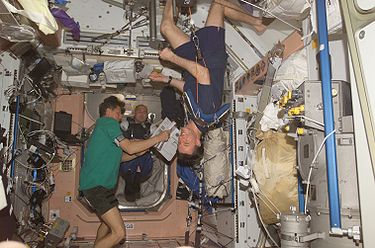
Weightlessness is the complete or near-complete absence of the sensation of weight, i.e., zero apparent weight. It is also termed zero g-force, or zero-g (named after the g-force)[1] or, incorrectly, zero gravity.
Microgravity environment is more or less synonymous in its effects, with the recognition that g-forces are never exactly zero.
Weight is a measurement of the force on an object at rest in a relatively strong gravitational field (such as on the surface of the Earth). These weight-sensations originate from contact with supporting floors, seats, beds, scales, and the like. A sensation of weight is also produced, even when the gravitational field is zero, when contact forces act upon and overcome a body's inertia by mechanical, non-gravitational forces- such as in a centrifuge, a rotating space station, or within an accelerating vehicle.
When the gravitational field is non-uniform, a body in free fall experiences tidal forces and is not stress-free. Near a black hole, such tidal effects can be very strong, meeting to spaghettification. In the case of the Earth, the effects are minor, especially on objects of relatively small dimensions (such as the human body or a spacecraft) and the overall sensation of weightlessness in these cases is preserved. This condition is known as microgravity, and it prevails in orbiting spacecraft.
- ^ "Weightlessness and Its Effect on Astronauts". Space.com. 16 December 2017.
The sensation of weightlessness, or zero gravity, happens when the effects of gravity are not felt.